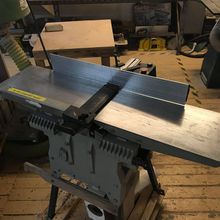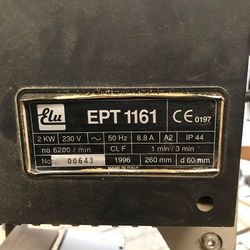Planer Thicknesser
| Planer Thicknesser | |
|---|---|
 | |
| Manufacturer | ELU |
| Model | EPT 1161 |
| Obtained | Long Term Loan (November 2015) |
| Location | Dusty Area |
| Team | Woodworking |
| Induction Required | Yes (use request form) |
| Tools: all pages • list • Power Tools • Broken tools {{}} | |
The Space has an ELU EPT 1161 Planer Thicknesser, on long term loan from Jelly.
Inductions
The Planer-Thicknesser is an induction tool, and an Induction can be requested via this form
The induction process can be as short as 10-15 minutes for an experienced user or as long as you feel necessary to be comfortable using the machine if you're just starting out.
Currently access to the machine is limited by a physical lockout and combination padlock, which will in the fullness of time be replaced with an RFID system.
What It Does
The Planer-Thicknesser, carries out it's eponymous operations of Planing and Thicknessing Solid Wood.
This allows a rough hunk of timber, to become a pristine board for joinery & cabinetry, picture framing, luthiery or just looking at, I guess.
The machine also enjoys an occasional coat of beeswax being rubbed on it's tables, you should do this in much the same way as you'd rub the belly of a friendly cat. That is: remembering it still has sharp bits, even if they're not in active use.
Planing
Taking a rough and/or not flat surface, and producing a smooth, flat one.
This is the first operation, in making your board.
Facing
Initially, one of the wider surfaces is planed flat, if you have a piece of timber which is bowed (bent along its length) or cupped (bent across it's width) the face which will have points of contact at both ends/sides should be used for this first face.
The Timber should be run across the cutters using the outfeed table as a reference surface, by repeatedly taking gentle passes in this way until no roughness, cupping or bowing remains, a face can be established on the timber.
Edge
to get a straight, perpendicular edge (or other angled edge, as the fence can accommodate anything from 45°-90°) the timber is then run across the cutters with the initial face referenced against the fence, and allowed to sit on the tables and cutter block under it's own weight, applying minimal downward pressure.
Thicknessing
This is the second, less involved function, and will use the face and edge defined by planing to produce an accurately-sized board with perfect parallelism.
The face and edge defined earlier are placed on the bottom, thicknessing table and allowed to engage with the power feed rollers, which pass the board under the cutter block, to create a second, parallel face and edge.
When attempting to use the thicknessing function to define the second edges of thin boards, give due consideration to how stable they may be resting on a thin face, running several through next to each other for stability may be the wisest course of action, and in some cases it may be neccessary to use the original planed face to edge both sides on the planer, rather than using the thicknessing function.
What it Does Not
- Pallet wood
- Due to grit and undetected nails causing damage, expense and lengthy down time in the past, use of the planer thickneser for processing reclaimed pallets is not allowed.
- Work with manufactured panel products, not limited to but including:
- Plywood
- MDF
- OSB
- Formica/Melamine
- Work with plastics.
- Like to find metal objects embedded within the wood it's planing.
- Like force being applied to the infeed, outfeed or thicknessing tables.
- Like removing hard surface coatings like paint or varnish.
- Enjoy beverages, hot or cold. You should never give it a beverage, not even just to hold.
It is important to respect the machine's dislikes. Failing to do so will result in it becoming unhappy and intentionally dulling or chipping its knives whilst no-one is looking; to prevent future hackers from getting a good surface finish on their work when using it.
Issues
Currently, due to space there are some issues.
Extraction
The planer shares an extraction hose with the wood turning lathe. Simply push the free end of the hose onto the homemade box that fits beneath the planer. Currently we do not have a collecting shroud for when the machine is used as a thicknesser.
In general, failing to use the chip extractor will result in more shavings than you can shake a silky-smooth recently planed stick at, and these will be ejected to a bunch of different places, just alllll over, you know... As such, however much it might seem like hassle to setup the extraction for a tiny job, it will be easier than sweeping up.
Storage
Storage space is also limited, currently the machine has made it's home next to the lathe in the dusty area. this is not ideal, as this is also where the table extension for the Dimension Saw goes when in use. Any person who can successfully identify a better place for it to live will be rewarded with a refreshing beverage, on delivering their suggestion and preference in beverage to Jelly.
Working Space
Again due to the Extending Table of the Dimension Saw, there may be times where there simply is not space available to set up the planer until other hackers have finished. Even when they have, space can be tight and it's important to think about where people will be, where you will be and where your wood will come from and go to, before starting.
The Future
The current loaned machine is hopefully a stop-gap or possibly gateway machine, towards the renovation and installation of a more substantial machine, there is one which could be available to the space once restored suitably which would eclipse the current one (both in terms of capabilities and being lined up with a strong light source).
With this in mind, any options for siting the machine more permanently during re-arrangement or upgrade of space facilities, are best discussed in terms of the larger machine which will hopefully follow, rather than the current small one.
Power
